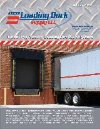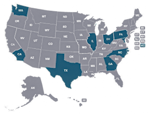Comprehensive FAQ for Dock Seals in the Loading Dock Industry
What Are Loading Dock Seals?
Dock seals are protective barriers installed around the perimeter of a loading dock door to create a tight, weather-resistant seal between the warehouse and the trailer of a truck during loading or unloading. Typically made from foam pads covered with durable fabric or inflatable materials, dock seals compress against the trailer to block out external elements like rain, snow, dust, pests, and extreme temperatures, while also improving energy efficiency and safety.
Back to Top
How Do Dock Seals Differ from Dock Shelters?
Dock seals and dock shelters both aim to control the environment at the loading dock, but they function differently:
- Dock Seals: Form a tight, compressive seal by pressing foam or inflatable pads directly against the trailer’s rear, ideal for uniform trailer sizes and smaller door openings. They provide superior sealing (up to 90% airflow control) but require precise trailer alignment.
- Dock Shelters: Use fabric curtains with springsteel stays to surround the trailer (ours don't use fiberglass), offering flexibility for varying trailer sizes and less wear from compression. They are less airtight but more durable and forgiving for misaligned trucks.
Choose seals for maximum sealing efficiency and shelters for versatility with diverse trailer types along with less wear on the seal from loading and unloading.
Back to Top
What Are the Main Benefits of Using Dock Seals?
Dock seals offer multiple advantages for warehouse operations:
- Energy Efficiency: By sealing gaps, dock seals prevent heated or cooled air from escaping, reducing HVAC costs. This is critical for climate-controlled warehouses storing food, pharmaceuticals, or electronics.
- Safety: Seals keep out rain, snow, and ice, reducing slip-and-fall risks.
- Product Protection: Seals block pests, dust, and weather, safeguarding sensitive cargo like food or chemicals from contamination or spoilage.
- Extended Dock Lifespan: By reducing wear on dock doors and edges, seals lower maintenance and replacement costs.
- Productivity: A sealed, comfortable environment boosts worker morale and efficiency, speeding up loading/unloading processes.
- Security: Seals deter unauthorized entry, enhancing facility security.
Back to Top
What Types of Dock Seals Are Available?
Dock seals come in various configurations to suit different dock setups and trailer types:
- Fixed Head Dock Seal: Features foam-filled side and head pads, ideal for uniform trailer heights and standard docks. Highly energy-efficient.
- Head Curtain Dock Seal: Uses foam side pads with a stationary or adjustable fabric head curtain, suitable for varying trailer heights. Optional foam-filled curtains enhance sealing.
- Adjustable Head Pad Dock Seal: Similar to head curtain seals but with a foam head pad, less common due to maintenance challenges with moving parts.
- L-Shaped Dock Seal: Designed for wider doors, seals the trailer’s sides rather than the rear, improving access to the trailer’s back. Available with fixed or curtain headers.
- Inflatable Dock Seal: Inflates using a blower when the trailer is docked, often interlocked with the door or leveler. Offers excellent sealing for varied trailer sizes, but is prone to damage from forklift loads.
- Under-Leveler Seals: Close gaps below the dock leveler, enhancing environmental control and sanitation.
- Specialty Seals: Include features like fire-resistant materials, reinforced wear pleats, or quick-mount systems for easy cover replacement.
Back to Top
How Do I Choose the Right Dock Seal for My Facility?
Selecting the right dock seal depends on several factors:
- Trailer Types: Uniform semi-trailers work well with fixed head seals, while varied trailers (e.g., straight trucks with step bumpers) may require head curtain or inflatable seals.
- Door Size: Standard doors (8’x9’) suit most seals, but larger openings (up to 12’x12’) may need L-shaped or inflatable seals.
- Dock Height and Approach: Standard 48” docks with level approaches need 4” bumper projection and 10” seal projection. Declined or inclined approaches require tapered pads or deeper bumpers to ensure proper compression.
- Traffic and Weather: High-traffic docks or extreme weather conditions demand durable materials like reinforced vinyl or neoprene.
- Special Requirements: Consider fire-rated materials, pest control, or integration with smart sensors for advanced facilities.
Consult with a dock equipment supplier to assess your dock’s specifications and operational needs.
Back to Top
How Do I Measure for a Dock Seal?
Accurate measurements ensure a proper fit and effective sealing:
- Door Opening: Measure the height and width of the dock door opening. Common sizes range from 8’x8’ to 10’x10’.
- Bumper Projection: Measure the distance from the dock face to the outermost edge of the dock bumpers (typically 4” for level approaches).
- Compression Ability: Determine the seal’s projection (e.g., 10” standard) to ensure adequate compression against the trailer. Account for trailer types (e.g., step bumpers may need more projection).
- Dock Approach Grade: For declined or inclined approaches, calculate the trailer grade (rise/600) to adjust seal taper or bumper projection. For example, a 1% slope requires an extra 1” projection at the top.
- Special Conditions: Note any unique needs, such as oversized trailers, fire resistance, or extreme weather.
We specialize in getting you the correct seal for your dock, if you have any questions give us a call 1800-741-1258.
Back to Top
How Are Dock Seals Installed?
Installation varies by seal type but generally involves:
- Mounting Brackets: Secure angle brackets to the seal’s backer board using lag screws, then anchor to the dock wall or door frame with appropriate fasteners (not included, as wall types vary).
- Positioning Verticals: Align vertical pads so their inside edges are flush with the door opening. Exception when the seals are intended to be offset, Use the header width to determine placement.
- Securing to Wall: Ensure brackets anchor to a firm surface (e.g., concrete or metal frame). For metal buildings, additional bracing is required.
- Header Installation: Attach the head pad or curtain, ensuring it compresses against the trailer top. For inflatable seals, connect the blower and interlock system.
- Testing: Back a trailer into the dock to confirm the seal compresses properly without gaps.
Back to Top
How Do Declined or Inclined Dock Approaches Affect Seals?
A sloped approach impacts seal compression:
- Declined Approach: The trailer’s top is closer to the wall than the bottom, risking over-compression at the top. Tapered vertical pads or deeper bumpers (e.g., 6” instead of 4”) are needed.
- Inclined Approach: The trailer’s bottom is closer, potentially leaving the top uncompressed. Tapered pads or adjustable head curtains ensure a tight seal.
Calculate the grade (e.g., rise/600) to determine the required bumper projection or pad taper. For example, a 53’ trailer on a 1% decline needs an extra 1” projection at the top.
Back to Top
What Maintenance Do Dock Seals Require?
To ensure longevity and performance:
- Regular Inspections: Check for tears, punctures, or wear in the fabric or foam, especially in high-traffic docks. Inspect after heavy use or extreme weather.
- Cleaning: Remove dirt, debris, or mold with mild soap and water to prevent material degradation.
- Replace Worn Parts: Replace damaged covers or foam pads promptly. We offer both recovers and replacement pads.
- Check Inflation Systems: For inflatable seals, ensure blowers and interlocks function correctly.
- Schedule Testing: Conduct regular equipment tests (e.g., quarterly) to meet OSHA compliance and prevent failures.
Replace seals every 5–10 years, depending on usage and conditions, or when significant wear is evident.
Back to Top
How Do Dock Seals Impact Energy Efficiency?
Dock seals reduce energy loss by:
- Minimizing Air Exchange: A tight seal prevents heated or cooled air from escaping, reducing HVAC workload.
- Insulation: Advanced seals use high-quality insulation materials like reinforced rubber or neoprene for better thermal resistance.
- Smart Integration: Modern seals with sensors monitor performance and alert for maintenance, optimizing energy use.
Energy savings can offset the cost of seals within months, especially in climate-controlled facilities.
Back to Top
Are Dock Seals Suitable for Food Safety or Sensitive Cargo?
Yes, dock seals are critical for food safety and sensitive cargo:
- Temperature Control: Seals maintain low temperatures for refrigerated or frozen goods, preventing bacterial growth or spoilage.
- Contaminant Protection: They block pests, dust, and moisture, ensuring compliance with Food Safety Modernization Act guidelines.
- Sanitation: Seals create a cleaner environment, reducing contamination risks for food, pharmaceuticals, or electronics.
Use under-leveler seals and insulated dock doors for maximum protection in temperature-sensitive operations.
Back to Top
What Are the Costs of Dock Seals?
Costs vary based on type, size, and features:
- Basic Foam Seals: $500–$1,500 per door for standard sizes.
- Inflatable Seals: $2,000–$5,000 per door due to blowers and interlocks.
- Specialty Seals: Higher for fire-rated or reinforced materials.
Installation costs range from $300–$2,000, depending on complexity. Energy savings and reduced maintenance often recoup costs quickly.
Back to Top
Can Dock Seals Be Used with All Trailer Types?
Dock seals work best with uniform trailers (e.g., over-the-road semis without step bumpers). For straight trucks with steps (projecting 12” or more), standard 9” projection seals may leave gaps. for these consider a dock shelter or designate a specific door for these trucks.
Back to Top
How Do I Know When to Replace Dock Seals?
Replace dock seals when:
- Visible Damage: Tears, punctures, or worn foam reduce sealing effectiveness.
- Poor Compression: Seals no longer compress tightly against trailers, allowing air or pests to enter.
- Energy Loss: Increased HVAC costs indicate seal failure.
- Age: Most seals last 5–10 years with proper maintenance.
Regular inspections help identify replacement needs early.
Back to Top
Where Can I Purchase Dock Seals?
Loading Dock Supply offers consultation and sales for both Dock Seals and Shelters. Our proffessional team is able to guide you through the process of acquring dimensions and trouble shooting problems with installation and repair.
Back to Top
How Do Dock Seals Enhance Safety?
Dock seals improve safety by:
- Reducing Slips: Keeping floors dry by blocking rain and snow.
- Preventing Accidents: Acting as a soft barrier to protect the facility and trucks from docking impacts.
- Improving Air Quality: Blocking dust and carbon monoxide, ensuring safer working conditions.
- Enhancing Visibility: Some seals include high-visibility markings to reduce collision risks.
Pair seals with vehicle restraints and clear signage for maximum safety.
Back to Top
How Thick Should My Dock Seal Be?
Your dock seal depth is determined by the slope of your approach and the dock bumper thickness. Level approaches typically have 4.5" thick dock bumpers and a 9"-10" thick seal. For each degree of slope, add or reduce an inch of projection depending on whether the slope is an incline or decline.
Back to Top
Why Is the Dock Seal Top Head Pad Getting Damaged?
If your top pad is receiving more damage than other parts of your seal, there are several reasons it could be happening. The most common reason is a sloped approach. When the dock slopes down and the dock bumpers are not thick enough, the truck will hit the wall or over-compress the top of the seal, causing it to wear out early. The way to avoid this situation is a wedged seal with adequate dock bumper projection.
Back to Top
Where to Buy a Loading Dock Wrap Around Seal?
There are many terms used in the door industry to describe what we call dock seals; we often hear them called dock wrap around, dock bumper cushions, door pads, docking pads, etc. Loading Dock Supply, experts in this field, offer a full range of dock seals, truck shelters, and other dock equipment with same-day quotes most handled on the phone.
Back to Top
|




